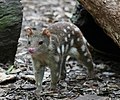Barmah National Park
| Barmah National Park | ||
|---|---|---|
|
|
||
| Location: | Victoria , Australia | |
| Specialty: | River-Red-Gum- Eucalyptus, waterfowl | |
| Next city: | Barmah | |
| Surface: | 285.21 km² | |
| Founding: | 2009 | |
The Barmah National Park is a national park in the north of the Australian state of Victoria . It lies between the towns of Barmah and Strathmerton on the Murray River , about 225 kilometers north of Melbourne .
history
The area was explored as early as the late 1830s and settled soon after. It was used as pasture for sheep and cattle . Logging in the forests took place in particular for the production of construction timber. Charcoal was also produced here . Traces of these old uses can still be seen in the area today.
But long before the European settlement, Aborigines of the Yorta Yorta tribe lived in the area , as archaeological finds prove.
Protected position
The state government of Victoria placed Barmah National Park under protection in 2010 as one of four facilities. This countered the progressive extermination of the forests of red eucalyptus ( Eucalyptus camaldulensis ), the world's largest occurrence of which is still here. These trees are of great natural, cultural and also economic importance, they can be up to 500 years old and up to 45 meters high. They can easily survive floods caused by the Murray. In addition to climate change, the other three parks were Gunbower National Park , Lower Goulburn National Park and Warby Ovens National Park .
Flora and fauna
- Bird species in the national park
The Barmah National Park belongs to the much larger Important Bird Area of Barmah-Millewa . There, populations of the Australian bittern , the black-tailed parakeet , the flam- breasted flycatcher (Petroica phoenicea) and the diamond finch are protected worldwide . The park also serves as a habitat for many waterfowl breeding there during floods. A total of more than 200 bird species have been identified so far. These include the brolga crane , the red-backed heron , spoonbill , sea eagle , azure fisherman and emu . Rare mammal species are the mean flying squirrel bucket , the great brushtail bucket and the giant bag marten . The gray kangaroo and the koala are common. There are also 38 rare and endangered plant species in the national park.
- Mammal species in the national park
tourism
There are several hiking trails in the park, including camping, boating, fishing and swimming.
Web links
- Information about the Barmah National Park from Parks Victoria
Individual evidence
- ↑ a b c d Leaflet from the National Park Administration with site plan (PDF; English)
- ↑ IBA: Barmah-Millewa . Birdata. Birds Australia
- ↑ a b Visitor information on the animal world (PDF; 4.2 MB)
- ↑ Management plan of the park. (PDF; English)
- ↑ Leisure activities National Park Administration










